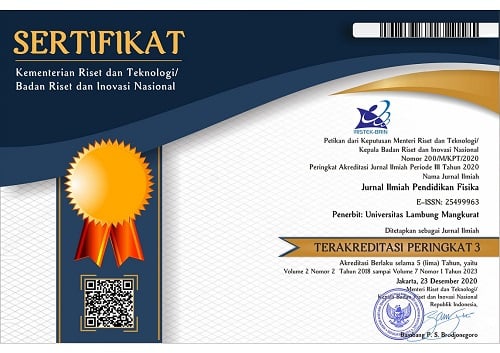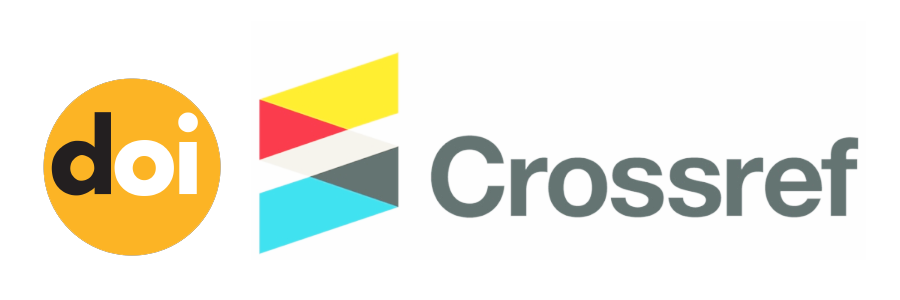Validity of Interactive Learning Media Integrated Critical and Creative Thinking Skills Aided by the Lectora Inspire Application
Abstract
The importance of the ability to think critically and creatively in the learning process, especially in physics, is a challenge for educators to continue to improve the quality of learning, both in implementing the learning process and developing appropriate learning resources. This study aims to develop valid interactive learning media with the help of the Lectora Inspire application to improve the critical and creative thinking skills of high school students, especially in straight and parabolic motion material. The research design used the ADDIE model, including the stages of analysis, design, development, implementation, and evaluation. This research is being developed through validation activities from three validators from the Padang State University physics department. The instrument for collecting data was an interactive learning media assessment sheet validated by experts. The subjects of this study were experts from the physics department lecturer Padang State University. The data analysis technique used Aiken's validity index. The validation results of learning media product development are in a very valid category, with an average value of 0.816. This indicates that interactive learning media that integrates critical and creative thinking skills with the help of the Lectora Inspire application have a very valid category. This validity component shows the feasibility of the product in material substance, audio-visual communication display, learning design, software utilization, assessment of critical thinking skills, and assessment of creative thinking skills.
Keywords
Full Text:
PDFReferences
Abas, Z. W. (2015). Fostering learning in the 21 st century through student engagement. International Journal for Educational Media and Technology, 9(1).
Agustina, I., Astuti, D., Sumarni, R. A., & Bhakti, Y. B. (2019). Pengembangan multimedia interaktif berbasis lectora inspire ssebagai media pembelajaran guru. Abdimas Dewantara, 2(2), 107–114.
Anggraeni, D. M., & Sole, F. B. (2018). E-learning moodle, media pembelajaran fisika abad 21. Jurnal Penelitian dan Pengkajian Ilmu Pendidikan: E-Saintika, 1(2), 57. https://doi.org/10.36312/e-saintika.v1i2.101
Dahlia, D., Rianto, S., & Yuherman, Y. (2022). Pengembangan media pembelajaran interaktif berbasis lectora inspire dalam meningkatkan hasil belajar siswa kelas x lintas minat pada mata pelajaran geografi di sman 1 padang sago. Jambura Geo Education Journal, 3(2), 106–113. https://doi.org/10.34312/jgej.v3i2.16098
Facione, P. A. (2016). Critical thinking: What it is and why it counts. Insight Assessment.https://www.researchgate.net/publication/251303244
Hartini, S., Misbah, M., Dewantara, D., Oktovian, R. A., & Aisyah, N. (2017). Developing learning media using online prezi into materials about optical equipments. Jurnal Pendidikan IPA Indonesia, 6(2), 313-317.
Hartini, S., Mariani, I., & Sulaeman, N. F. (2020, June). Developing of students worksheets through STEM approach to train critical thinking skills. Journal of Physics: Conference Series, 1567(4), 042029.
Hufri, H., & Triani, F. (2022). Practicality of basic electronics module integrating creative thinking in diode circuit material and its application. Journal of Physics: Conference Series, 2309(1). https://doi.org/10.1088/1742-6596/2309/1/012071
Hussin, A. A. (2018). Education 4.0 made simple: Ideas for teaching. International Journal of Education and Literacy Studies, 6(3), 92-98.
Istiqlal, M. (2017). Pengembangan multimedia interaktif dalam pembelajaran matematika. JIPMat, 2(1).
Jennah, R. (2009). Media pembelajaran.Banjarmasin : Antasari Press
Khairunnisa, G. F., & Ilmi, Y. I. N. (2020). Media pembelajaran matematika konkret versus digital: systematic literature review di era revolusi industri 4.0. Jurnal Tadris Matematika, 3(2), 131–140. https://doi.org/10.21274/jtm.2020.3.2.131-140
Kurniawan, A., Ashari, A., & Maftukhin, A. (2017). Pengembangan Media Pembelajaran Menggunakan Software Lectora Inspire untuk Meningkatkan Motivasi Belajar Fisika Siswa Kelas X MAN Purworejo Tahun Pelajaran 2016/2017. Radiasi: Jurnal Berkala Pendidikan Fisika, 10(1), 35-40.
Mahyuddin, R. S., Wati, M., & Misbah, M. (2017). Pengembangan media pembelajaran fisika berbasis zoomable presentation berbantuan software prezi pada pokok bahasan listrik dinamis. Berkala Ilmiah Pendidikan Fisika, 5(2).
Manurung, S. R. (2020). Improving students’thinking ability in physics using interactive multimedia based problem solving. Jurnal Cakrawala Pendidikan, 39(2), 460-470.
Misbah, M., Hamidah, I., Sriyati, S. I. T. I., & Samsudin, A. C. H. M. A. D. (2022). A bibliometric analysis: research trend of critical thinking in science education. Journal of Engineering Science and Technology, 17, 118-126.
Mulyono, M., & Ampo, I. (2021). Pemanfaatan media dan sumber belajar abad 21. Paedagogia: Jurnal Pendidikan, 9(2), 93–112. https://doi.org/10.24239/pdg.vol9.iss2.72.
Novela, R., Yulia Sari, S., & Darvina, Y. (2019). Analisis validasi lks berorientasi hots dalam model inkuiri terbimbing pada materi gerak lurus, gerak parabola dan gerak melingkar. Physics Education, 12(4), 657–664.
Nursidik, H., Resti, I., & Suri, A. (2018). Media pembelajaran interaktif berbantu software Lectora inspire. Desimal: Jurnal Matematika 1(2), 237–244.
Putri, A. A., & Ardi, A. (2021). Meningkatkan hasil belajar siswa melalui multimedia pembelajaran interaktif berbasis pendekatan saintifik. Edutech Undiksha, 8(1), 1–7.
Putri, I. A., Siswoyo, S., & Indrasari, W. (2016). Pengembangan media pembelajaran fisika menggunakan lectora inspire pada materi usaha dan energi SMA. Jurnal Penelitian & Pengembangan Pendidikan Fisika, 2(2), 71-78.
Purnama, S. (2010). Elemen Warna Dalam Pengembangan Multimedia Pembelajaran Agama Islam.
Rahim, F. R., Sari, S. Y., Sundari, P. D., Aulia, F., & Fauza, N. (2022). Interactive design of physics learning media: The role of teachers and students in a teaching innovation. Journal of Physics: Conference Series, 2309(1). https://doi.org/10.1088/1742-6596/2309/1/012075
Redhana, I. W. (2013). Model pembelajaran berbasis masalah dan pertanyaan socratik untuk meningkatkan keterampilan berpikir kritis siswa. Jurnal Cakrawala Pendidikan, 3. https://doi.org/10.21831/cp.v0i3.1136
Rizki, M., Wati, M., & Misbah, M. (2021). Electronic thermodynamics teaching materials based on authentic learning to practice students’ problem-solving skills: Aspects of validity. Journal of Physics: Conference Series, 2104(1), 012018.
Sari, S. Y., Darvina, Y., Rahim, F. R., Sundari, P. D., & Aulia, F. (2022). Analysis of student’s higher order thinking skill in answering on the physics national exam. Journal of Physics: Conference Series, 2309(1). https://doi.org/10.1088/1742-6596/2309/1/012079
Saputri, S. R., Wati, M., & Misbah, M. (2021). Simple harmonic motion electronic teaching materials based on authentic learning to train students’ problem-solving skills: aspects of validity. Journal of Physics: Conference Series, 2126(1), 012016.
Setyorini, A. I., Carolina, N., & Artikel, I. (2022). Pengembangan media pembelajaran interaktif berbantuan software lectora inspire untuk siswa smp. Jurnal Nasional Pendidikan Matematika, 6(3). https://doi.org/10.33603/jnpm.v6i3.6140
Sodirjonov, M. M. (2020). Education as the most important factor of human capital development. Theoretical & Applied Science, (4), 901-905.
Soenarto, S., Sugito, Suyanta, Siswantoyo, & Marwanti. (2020). Vocational and senior high school professional teachers in industry 4.0. Cakrawala Pendidikan, 39(3), 655–665. https://doi.org/10.21831/cp.v39i3.32926
Sugiyono, S. (2015). Metode penelitian pendidikan pendekatan kuantitatif, kualitatif, dan R&D. Bandung: Alfabeta
Sunaryo, S., Serevina, V., Khairunisa, S. G., & Hasni, M. R. (2022). Development of physics learning interactive multimedia integrated with student worksheets on the subject of vibration for high school students. Journal of Physics: Conference Series, 2309(1).
https://doi.org/10.1088/1742-6596/2309/1/012070
Suryani, K., Utami, I. S., Khairudin, K., Ariska, A., & Rahmadani, A. F. (2020). Pengembangan modul digital berbasis stem menggunakan aplikasi 3d flipbook pada mata kuliah sistem operasi. Mimbar Ilmu, 25(3), 358–367.
Tahel, F., & Ginting, E. (2019). Perancangan aplikasi media pembelajaran pengenalan pahlawan nasional untuk meningkatkan rasa nasionalis berbasis android. Jurnal Teknologi Dan Informatika, 09(02), 113–120.
Tambunan, I. R., & Purba, S. (2017). Pengembangan media pembelajaran berbasis aplikasi lectora inspire untuk mata pelajaran dasar dan pengukuran listrik kelas x di smk swasta imelda medan. Jurnal Manajemen Pendidikan, 9(1), 24–34.
Zainuddin, Z., Hasanah, A. R., Salam, M. A., Misbah, M., & Mahtari, S. (2019). Developing the interactive multimedia in physics learning. Journal of Physics: Conference Series, 1171(1), 012019.
DOI: https://doi.org/10.20527/jipf.v7i2.7404
Refbacks
- There are currently no refbacks.
Indexed by: Jurnal Ilmiah Pendidikan Fisika is licensed under a creative commons attribution-share alike 4.0 international license
Statistics Counter |
















